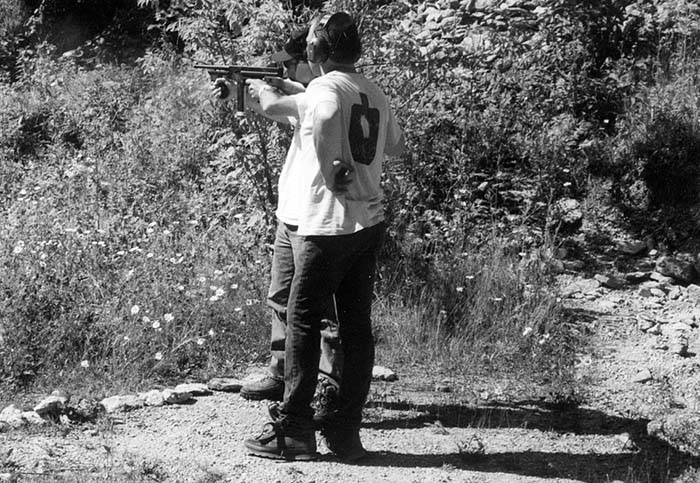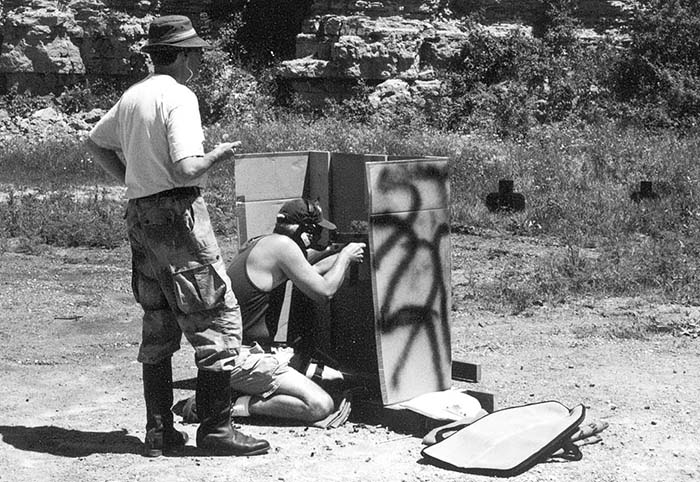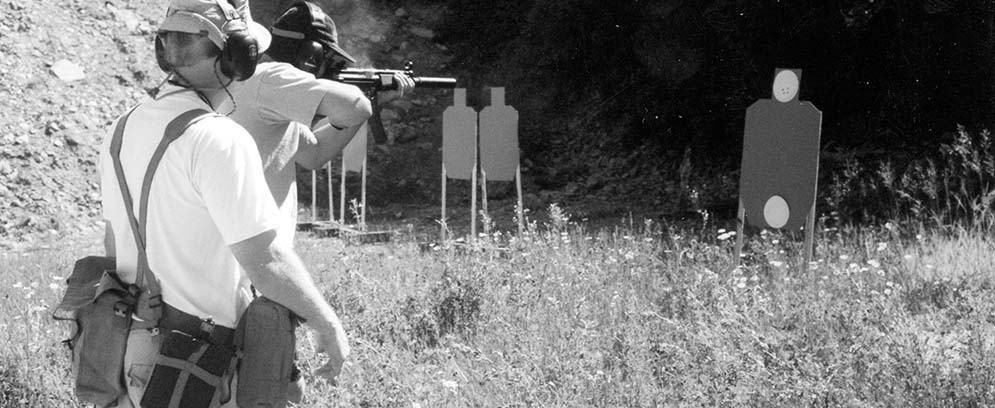By Lee Arten
Mount Horeb is a small town southwest of Madison, the capital of Wisconsin. It amused me to pass through Madison, home of the University of Wisconsin and a well-known liberal town, on the way to a subgun match. I smiled some more when I saw the number of MACs, Thompsons, MP5s and STEns unlimbered at Mount Horeb. If the liberals in downtown Madison only knew!
Although I heard about them just a couple of years ago, the matches in Mount Horeb have been run for six years. I attended the June 24, 2001 match and found three courses set up for pistol caliber subguns.
The first course was Subgun Basics. It was divided into three stages, the first of which tested control. Shooters loaded a magazine of 10 rounds and fired all 10 into the A zones of an IPSC type target in one burst. Two targets were set up, one at seven and one at 15 yards. Seconds were added to the shooter’s scores for each shot that hit outside the A zone. A perfect score was 0 seconds.

Stage two tested accuracy. Two six-inch round paper targets were stapled to IPSC type targets set at five, 10 and 15 yards. Shooters had to fire at least three shots into each target with one pull of the trigger. Seconds were added for each shot that missed the paper plates. Shooters were also penalized for firing more than one burst on a paper target.
Stage three tested speed. It was a timed course, shot from the underarm or hip position. Targets were four IPSC targets at eight yards and one steel target at 11 yards. Each paper target had to have at least two hits and the steel target had to be knocked down. I had a mag that malfunctioned on this stage and it hurt me badly.
SMG Basics is shot at every match, and makes up the Short Match. The field courses vary. At the June match, Field Course One was shot from a bunker and had a 45 second time limit. A mixture of 24 paper and steel targets were set in front of the bunker, some nearly hidden in the grass. I was told that paper targets needed three hits to count and steel targets should be knocked over. The winner on this course, Marc Siem, got all the targets in 15 seconds. I took the whole time available and still left several targets standing. Bobbling a mag change with my Madsen M50 didn’t help.
Field Course Two had a mixture of paper shoot and no-shoot targets, which had to be hit at least twice, and three steel cylinders as stop plates. Angles were important here since shots that went through one target and hit another counted. Knocking down all the cylinders too early stopped a shooter’s run, even if the shooter’s targets remained. I watched several shooters run the course and didn’t see anyone knock over the cylinders early, but it added a certain amount of anxiety to the stage. Richard Paulson won this stage with a 61.89 second time. I shot a time of 105.74, just a little above the average score on Field Course Two. That score included a hit on one no-shoot with a shot that went low on a shoot target, and hit a no-shoot behind it on the right side.
I got to the match, held at a gravel pit at 3180 Bergum Road, outside Mount Horeb, at about 9:30am, and was heading for home by about 12:30pm.
This included the usual amount of standing around, talking, and even a visit to the on-site gunsmith, Craig Miller, to have a balky magazine fixed. I could have been done sooner, if I’d shot more and talked less.
The match was put on by Wisconsin Class Three Sports Committee (WICTSC) and Arnold Harris, secretary-treasurer of the organization, was a match organizer.
Harris also officiated at the Shooter’s Meeting. He said the match was about,
“…safety, safety, safety, fun, more damn safety, and fun.”
Except when being fired on a course, on the practice range, or while cooling down, all guns had to be empty and cased. Between stages each one had a dowel rod run down the barrel to be sure it was clear, and then a chamber flag was inserted into the action. Although the match was held in a gravel pit with rock walls, I didn’t see one bounceback in the time I spent there. After the match, in a telephone interview, Harris told me that some bouncebacks had occurred June 24. He said a six foot high earth embankment will be built against the pit wall to reduce or eliminate bouncebacks, “from rounds striking hard rocks in the wall.” The match organizers are going to alter the setup somewhat, and have the shooters shoot in squads, to speed up the matches.
I thought the June match, which had 43 competitors, was well run, safe, and worth the time I spent. I recommended it to a man I met at a private shoot in Northern Wisconsin in July, and I’m also trying to get a couple of my friends to make the run to Mount Horeb with me.

The WICTSC holds four outdoor subgun matches a year. It also cooperates in a series of indoor subgun matches in winter at the Shooters Sports Center, 4900 Six Mile Rd, Racine, WI. It costs $20 to shoot the full match at Mount Horeb, ($15 for WICTSC members). The Short Match, (just SMG basics) costs $10.
For more information write WICTSC, PO Box 16, Mount Horeb, WI 53572. call 608-798-4833, or email Arnold Harris at ftdata@chorus.net.
| This article first appeared in Small Arms Review V5N5 (February 2002) |











